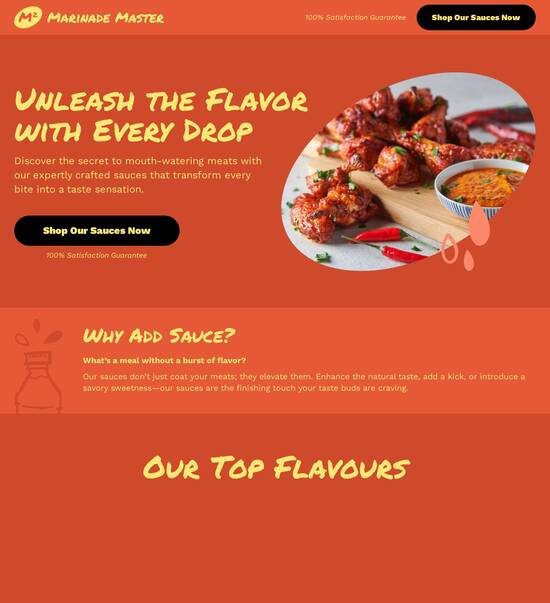
Web page template for emergency response teams
Use TemplateAbout template
Collaborate and optimize like never before with our landing page templates for emergency response teams. Ready to streamline your workflow?
Recommended templates

Easy to build without coding
With the intuitive drag-and-drop builder, anyone on your team can create high-converting pages without any knowledge of code or design. Make enhancements to your landing page with custom widgets using Javascript, HTML/CSS, or third-party scripts.

Multiple layouts for any industry and goal
Select from 500+ landing page layouts built to boost conversions across industry-specific scenarios. Customize them by adjusting fonts, adding images, and generating on-brand content with the AI assistant. Quickly scale with Instablocks® and Global Blocks that you can save, reuse, and update globally.

Loads fast and looks polished on any device
Every template is responsive, which means they present professionally on any device and load blazingly fast with our Thor Render Engine. You can also power them up with Google AMP technology to deliver an unparalleled mobile experience and drive higher conversions.

Robust analytics & experimentation
Get real-time updates and reporting across all your devices, showing the number of visitors, conversions, cost-per-visitor, and cost-per-lead. Launch AI-powered experiments, run A/B tests, and use heatmaps to analyze user behavior, then optimize your landing page to maximize conversions.







Easy to build without coding
With the intuitive drag-and-drop builder, anyone on your team can create high-converting pages without any knowledge of code or design. Make enhancements to your landing page with custom widgets using Javascript, HTML/CSS, or third-party scripts.
Multiple layouts for any industry and goal
Select from 500+ landing page layouts built to boost conversions across industry-specific scenarios. Customize them by adjusting fonts, adding images, and generating on-brand content with the AI assistant. Quickly scale with Instablocks® and Global Blocks that you can save, reuse, and update globally.
Loads fast and looks polished on any device
Every template is responsive, which means they present professionally on any device and load blazingly fast with our Thor Render Engine.
Robust analytics & experimentation
Get real-time updates and reporting across all your devices, showing the number of visitors, conversions, cost-per-visitor, and cost-per-lead. Launch AI-powered experiments, run A/B tests, and use heatmaps to analyze user behavior, then optimize your landing page to maximize conversions.
All the features you need to build ems website template
Explore more featuresLearn how to build website design for emergency medicine
Frequently asked questions about microsoft teams emergency operations center
Leading the way in building high-performing landing pages





Emergency response team template: Your ultimate how-to guide
Instapage offers powerful web page templates designed specifically for emergency response teams, optimizing your campaign effectiveness and maximizing ROI. With over 100 high-converting templates at your fingertips, you can launch tailored landing pages that engage your audience and enhance your digital marketing strategy.
Understanding the importance of web page templates
Using customized web page templates is critical for emergency response teams aiming to streamline communication and improve response coordination. These templates not only save time but also ensure that vital information is presented effectively. Instapage provides a user-friendly interface and flexibility to customize templates based on specific needs, making it an ideal solution for dynamic environments.
- Time efficiency: Pre-designed templates speed up the page creation process, allowing teams to focus on critical response efforts.
- Consistency: Maintain brand and messaging consistency across all marketing materials, reinforcing trust and recognition.
- Customization: Easily adapt templates for different emergencies, ensuring relevant information reaches the right audience promptly.
Steps to create your landing page
Building an effective landing page tailored for emergency response requires strategic steps. Below is a step-by-step guide to help you leverage Instapage's features.
- Choose the right template: Select from Instapage's extensive library of responsive templates tailored for service-oriented industries.
- Customize content: Use dynamic text replacement to align messaging with specific audiences, ensuring clarity in communication.
- Preview and optimize: Utilize A/B testing to measure performance and make data-driven adjustments, ensuring the page meets your objectives effectively.
Enhancing collaboration and feedback
A successful landing page necessitates input from various stakeholders to ensure it meets all operational needs. Instapage’s real-time collaboration features facilitate this effectively.
- Real-time editing: Collaborate with team members instantaneously, making the creative process faster and feedback more integrated.
- Secure sharing: Confidently share landing page drafts with external partners for review to enhance expertise in critical areas.
- Instant feedback loops: Capture insights from various sources quickly, allowing team members to iterate efficiently and improve final outputs.
In conclusion, using Instapage for crafting landing pages tailored for emergency response teams not only accelerates deployment but also boosts conversion rates, ultimately enhancing the effectiveness of your campaigns.
Start creating your emergency response landing pages today with Instapage and transform how you manage your digital marketing efforts. Explore our templates now!
People also ask about Web page template for emergency response teams
Web page template for emergency response teams
Understanding the need for tailored web solutions
Emergency response teams face unique challenges that require specialized solutions. The complexity and unpredictability inherent in emergencies demand efficient systems for communication and resource allocation. A clearly structured web page template can streamline operations, ensuring that essential information is readily accessible when time is of the essence.
Moreover, the imperative of timely communication cannot be overstated. When emergencies strike, the ability to disseminate critical updates swiftly to both responders and the public can significantly influence outcomes. Traditional web solutions often lack the necessary customization and flexibility, thereby hindering response efforts.
Complex situations that demand quick decision-making.
The importance of real-time data and updates.
Challenges with integration of existing communication tools.
Key features of emergency response web page templates
A well-designed web page template for emergency response teams should allow for immediate customization to facilitate the dissemination of crucial information. Team leaders can choose layouts and color schemes that resonate with their specific scenarios, ensuring that the most pertinent information is conveyed at a glance. For example, some situations may prioritize alerts, while others may emphasize resource availability.
Furthermore, real-time updates are essential. Templates should be capable of refreshing dynamically, allowing teams to modify alerts and instructions as situations evolve. This adaptability ensures that all stakeholders are operating with the latest information, a vital component in crisis management.
Customizable layouts for various emergency situations.
Real-time updates to inform users of changing circumstances.
Alerts prioritization to enhance visibility.
Interactive and responsive design elements
Given the unpredictable nature of emergencies, mobile optimization is crucial. Most individuals involved in emergency situations are likely to rely on their mobile devices. A responsive design ensures that web page templates function effectively across various screen sizes, facilitating access to important information in high-pressure scenarios. Features such as responsive images and touch-button navigation can enhance usability significantly.
In addition to mobile optimization, real-time communication tools like chat features can significantly improve responsiveness. These tools allow team members to connect instantly, discuss strategies, and share critical updates. Additionally, push notifications can be employed to alert users about urgent updates, further ensuring that all parties stay informed.
Mobile-friendly features for enhanced accessibility.
Responsive design for various devices.
Integration of chat features for real-time communication.
Utilizing JavaScript for enhanced functionality
JavaScript is a powerful tool that can be used to enhance user engagement on emergency response team web pages. Implementing document.addEventListener allows the website to respond to user interactions in real time. For instance, when users submit a contact form to request assistance or report an emergency, this function enhances the autofill feature, making it quicker and easier to communicate.
Additionally, managing dynamic content loading through the DOMContentLoaded event can vastly improve the user experience. By ensuring that essential resources load promptly, teams can avoid delays that could be detrimental during a crisis. This functionality plays a significant role in reducing friction in interactions, enabling swift access to vital information.
Enhancing interactivity through JavaScript functions.
Utilizing event listeners for better engagement.
Improving loading speeds for essential resources.
Essential sections to include in emergency response teams' templates
When designing a web page template for emergency response teams, certain sections are crucial for improving efficiency during crises. An Emergency Alerts and Announcements section should be prominently displayed, with a clear format that utilizes color coding to convey urgency. Easy access to alerts ensures that users can quickly grasp the situation and act accordingly.
Moreover, having a comprehensive Resource and Contact Directory helps responders locate essential contacts quickly. By categorizing these directories for various types of emergencies, teams can streamline communication during critical moments. Lastly, an Event Scheduling Calendar can facilitate training sessions and community engagement, allowing user sign-ups and reminders for essential drills.
Emergency alerts section with color coding.
Resource and contact directories for quick access.
Event scheduling calendars for training and engagement.
Best practices in content organization
Effective content organization is key in ensuring that information is readily available. Prioritizing information for quick access is essential; placing major alerts and updates at the top of the web page allows users to absorb critical information without scrolling. A balance between concise bullet-point lists and comprehensive explanations fosters efficient reading, making the site more navigable.
Establishing a consistent visual hierarchy can dramatically improve readability. Choosing appropriate typography and color schemes aids in guiding the user's eyes toward essential areas. Proper use of imagery and icons can enhance understanding, making complex information more digestible for users, ensuring that they can navigate the site effectively during emergencies.
Information prioritization for quick access.
Balancing brevity with detailed explanations.
Establishing consistent typography and color schemes.
Security considerations for online emergency platforms
Security must be a foremost consideration for any web page template designed for emergency response teams. Protecting user data integrity through measures such as implementing SSL certificates and data encryption ensures that sensitive information remains confidential. This level of security builds trust, which is vital in emergency communication where stakeholders need to feel safe sharing information.
Additionally, mitigating the risks posed by cyber threats is essential. Emergency situations can make platforms susceptible to attacks, so regular updates and security patches should be part of best practices. Attention should be paid to the security of user submissions and feedback channels, further reducing the likelihood of data breaches.
Implementing SSL certificates for data protection.
Regularly updating security measures to prevent breaches.
Ensuring secure channels for user feedback.
The role of analytics in enhancing future preparedness
Analytics provide valuable insights into user interactions that can inform better strategies in future emergencies. By tracking how users engage with the web page template, emergency response teams can identify areas for improvement. For example, if users frequently overlook a section critical for their response actions, adjustments can be made to enhance visibility.
Benchmarking against past responses is another powerful tool for continuous learning. Analyzing previous template performance can help teams discard ineffective features and refine those that proved successful. Utilizing reports and metrics effectively allows leaders to make informed decisions that improve future emergency responses.
Collecting data to inform better decision-making.
Benchmarking previous template performance for improvements.
Utilizing analytics for continuous process optimization.
Case studies and examples of effective implementations
Examining successful emergency response websites reveals insights into effective template features. Websites that include well-organized sections for emergency alerts, resource links, and real-time communication tools consistently provide a higher level of user satisfaction. User testimonials often underscore the importance of intuitive navigation and responsive design during crises, confirming the value of tailored web solutions.
Additionally, analyzing specific features that have led to outstanding performance can guide the development of future templates. Innovations born from user feedback ensure that templates evolve with the changing demands of emergency situations, resulting in more effective systems for response teams.
Exemplary sites showcasing effective features.
User testimonials reflecting website effectiveness.
Lessons learned from user feedback and experience.
Future trends in emergency response web solutions
The future of web solutions for emergency response teams appears promising, especially with advancements in AI and machine learning. These technologies can optimize how teams manage alerts and resources, making the systems even more responsive to real-time data. Innovations like predictive analytics may facilitate anticipating emergencies, allowing teams to react swiftly before situations escalate.
At the same time, community engagement through social media and other platforms is becoming increasingly relevant. By leveraging these connections, emergency response teams can enhance their outreach, ensuring that communities receive timely information. Moreover, collaborative tools that facilitate real-time coordination among team members can only drive efficiency, enhancing the overall effectiveness of emergency operations.
Potential for AI and machine learning to enhance response.
Importance of social media in community engagement.
Collaborative tools to improve team coordination.
Ready to skyrocket conversions?
Supercharge your ad campaigns with high-performing landing pages
Get started














